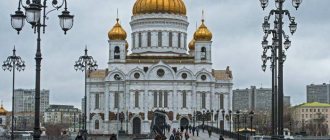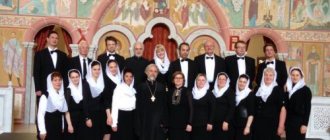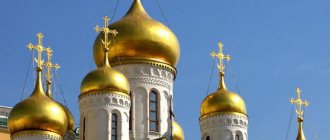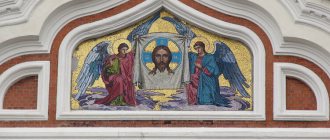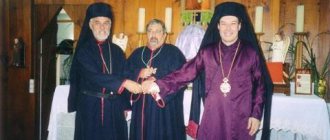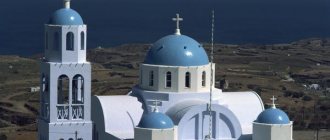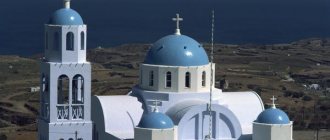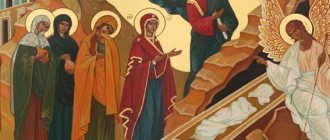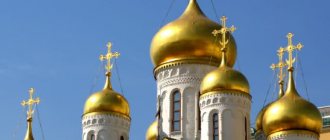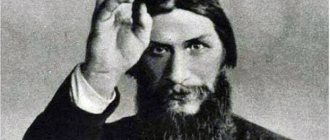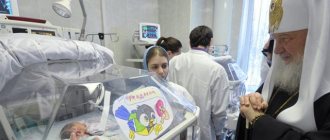| Nicosia St. John the Theological Cathedral |
Cypriot Orthodox Church
, autocephalous local Church
- Official site:
- Canonical territory: Cyprus (due to Turkish occupation of the north of the island, most believers live in the south)
- Liturgical language: Byzantine Greek
- Calendar: New Julian
- Cathedral: St. John the Theologian in Nicosia (also in Nicosia and the residence of the primate)
- Primate: Chrysostomos II, His Beatitude Archbishop of New Justiniana and all Cyprus
- Place in diptych: (10) [1]
- Composition: 18 bishops; 10 dioceses; 600 clergy (ca. 2005) [2]; 628 parishes (ca. 2005) [2]; OK. 28 monasteries (2012) [3]; 1 higher theological school; 654 thousand members (approx. 2005) [2]
Historical sketch
On the island of Cyprus, the apostles Paul, Mark and Barnabas preached the word of God, the latter of whom became the first ruling archpastor of the island and is especially honored here. Until 325, Cyprus was under the jurisdiction of the See of Jerusalem, then of Antioch. In the first half of the century, monasticism began on the island, associated with the names of St. Hilarion the Great, St. Nicholas of Myra, Equal-to-the-Apostles Constantine and Helen.
At the Third Ecumenical (Ephesian) Council in 431, the Church of Cyprus was declared autocephalous. The Antiochian primate subsequently again claimed control of Cyprus, but in 478 the tomb of the Apostle Barnabas was found on the island. This confirmed the apostolic foundation of the Church of Cyprus, thanks to which later that same year Emperor Zeno confirmed autocephaly and granted the archbishop "three privileges" - the right to sign with vermilion, to wear purple clothes instead of black under vestments, to use the royal scepter instead of the episcopal crozier.
Arab invasions in the 7th century forced the archbishop to flee the island to the Hellespont, where, under the protection of Emperor Justinian II, he founded a new city - New Justiniana. In 698, the Arabs were expelled from the island and the archbishop returned to the island, but from then on retained the title of Archbishop of New Justiniana.
During these centuries, many monks who left Syria and Palestine due to the Arab conquest of these lands, as well as defenders of icons from Asia Minor during the time of iconoclasm, sought refuge in Cyprus. Their stay strengthened Orthodoxy on the island and contributed to the founding of new monasteries. Also, the development of monasticism at this time was helped by Arab raids and natural disasters, since they were perceived as manifestations of Divine wrath and encouraged people to devote their lives to the Church and bequeath their property to the monasteries. The confrontation between the Arabs and the Byzantines in Cyprus ended in 965 with the victory of the latter, after which the emperor tried in every possible way to encourage monasticism on the island.
In 1191, Cyprus was conquered by the English king Richard the Lionheart, and in 1192 it was sold to the former king of Jerusalem, Guy de Lusignan, who founded the Latin Kingdom of Cyprus under the rule of the Roman Catholics. Latin rulers oppressed the Orthodox hierarchy, reducing the number of Orthodox bishops on the island from 14 to four. In 1220, the Catholic hierarchy was established in Cyprus, which existed there until 1571. Roman Catholic prelates tried to abolish Orthodoxy, forcing the Orthodox to make compromises in both dogma and customs. The Cypriot Orthodox Church was oppressed and robbed by Catholics, which caused protest and indignation among the Orthodox clergy. The transfer of power to the Venetians in 1489 did not bring fundamental changes to the position of the Orthodox Church.
With the occupation of the island by the Turks in 1571, the Orthodox regained many of their former benefits, but their position remained insecure, their lives and property were at the disposal of the Ottoman authorities. According to the practice prevailing in the Ottoman Empire, the Christians of Cyprus were considered a separate people - the Romans ("rum millet"), and the Orthodox Church - the only legal Christian Church. The Turks placed the Archbishop of Cyprus in the position of the political head of this nation, responsible for the collection of taxes and the trustworthiness of the flock. For this reason, the declaration of Greek independence in 1821 led to the death of Archbishop Cyprian and many prominent clergy and laity of the Church of Cyprus.
In 1878, with the occupation of the island by the British, the Orthodox Church gained more freedoms, including the right to use bells in churches. At the same time, the British authorities began to seriously interfere in church life, which led to a church uprising in October 1931, after which the British imposed additional restrictions on the election of the archbishop.
British occupation of the island continued until 1960, when Cyprus regained its independence and declared itself a republic with the election of Archbishop Macarius III as both the spiritual and political head of the country. This combination of powers continued until his death in 1977.
Taking advantage of an attempted military coup in 1974, Turkey invaded Cyprus and occupied its northern part, making up about a third of the island. Almost the entire Orthodox population of this part fled to the south, and the remaining Orthodox churches and properties in the north—514 churches, chapels, and monasteries—were mostly damaged and desecrated.
On October 24, 2022, Archbishop Chrysostomos of Cyprus for the first time remembered the name of the head of the schismatic OCU, Metropolitan Epiphanius (Dumenko), during the Liturgy. Thus, the Primate of the Cypriot Orthodox Church actually recognized the “Orthodox Church of Ukraine” as autocephalous. On November 20, 2022, the Holy Synod of the Russian Orthodox Church stated the impossibility of commemorating the name of Archbishop Chrysostomos II of Cyprus in diptychs, prayerful and Eucharistic communion with him, as well as concelebration with those hierarchs of the Cyprus Church who will enter into church communion with representatives of the Ukrainian schism [4]
Shrines in the Troodos mountains
High in the mountains, on the site of the discovery of relics, icons, and hermit cells, temples were erected that have survived to this day.
Kykkos Monastery
Among the mountain peaks, the most famous monastery of the island was built in the 11th century. Here lies an image of the Virgin Mary, painted during her lifetime by the Apostle Luke. She was brought from Constantinople by the will of the Holy Virgin. Emperor Alexei I Komnenos was forced to give up the icon, but on the condition that no one would ever see its face again.
By imperial decree, the monastery was founded, damaged by fire in the 13th and 15th centuries, but restored again. In the 18th century, a bell tower was added to it. Pilgrims come to pray to the image of the Kykkos Virgin Mary for the gift of health, and to venerate the sacred artifacts of the followers of Christ.
Monastery of the Mother of God Trooditissa
Trooditissa Monastery is located at an altitude of 1340 meters. Founded in the 13th century.
During Turkish rule it was burned. Restored in 1842. Widely known among believers for the image of the Mother of God Trooditissa by Luke and an unusual belt. Pilgrims believe that the Virgin Mary will hear prayer and help childless families find children.
Monastery of Our Lady of Trikukka
The monastery, the age of which historians argue about, is located high in the mountains. For a long time it was abandoned due to Ottoman rule. During this period, the icon of the Mother of God of Trikoukotissa disappeared without a trace.
It began to revive at the end of the 20th century, when the nuns returned here. The main relic is a copy of the missing image. Believers ask in their prayers to save them from infertility and natural disasters.
Temple of the Holy Martyr Maura
On the mountainside, on the banks of the Krios Potamos River, there is a small church. She bears the name of Maura, a preacher of Christianity in Egypt. The Romans crucified her along with her husband Timothy for renouncing her beliefs.
After 8 centuries, the relics of Mavra were discovered in the Trooditissa mountains, where the church was erected. There are frescoes on the walls dating from the 12th to 15th centuries. During the rule of the Ottomans, the relics disappeared. The active temple is famous for its spring gushing out of a rock nearby. The healing properties of water help with respiratory diseases.
Primates
- Gelasius? — 325
- St. Epiphanius I (368-403)
- St. Savin I (403 - ?)
- Troilus? — 431
- Rigin 431 — ?
- Olympius I? — 449-451
- Savin II? — 457-458
- Anfemia? — 470
- Olympius II
- Philoxen
- St. Damian
- St. Sophronius I (VI century)
- Gregory I
- Arkady I
- Plutarch (? - 620-625)
- Arkady II (? - 630-641)
- Sergius (? - 643)
- Epiphanius II (? - 681-685)
- John I (? - 691)
- St. George I (? - 750)
- St. Constantine (mentioned 783-787)
- Epiphanius III (? - 870)
- Eustathius (c. 890)
- Basil
- Nikolay Muzal (? - 1100)
- John II the Cretan (? - 1151-1174)
- Barnabas II (1175-)
- Sophronius II ( - 1191)
- Isaiah (- 1209)
- Neophyte II (1222-1251)
- George II (1251) [5]
- Germanus I Pisimander (1251 - 1260)
- Timothy (1572 - 1575)
- Lawrence (c. 1580)
- Neophyte III (1587 - 1592)
- Athanasius I (1592 - June 1600)
- Benjamin (1601 - 1605)
- Christodoulus I (1606 - 1639 and 1640-1641)
- Parthenius (1639 - 1640)
- Nikephoros (1641 - 1672/3)
- Hilarion Kigala (1674 - 1682)
- Christodoulus II (1682 - 1690?)
- James I (1690? - 1694?)
- Hermann II (1694 - 1705)
- Athanasius II Dabbas (1705 - 1710), recognized as legitimate in 1707, at the beginning of the same year he left for Constantinople and never returned
- James II (1710 - 1718)
- Sylvester (1718 - 1733)
- Philotheus (1734 - 1759)
- Paisiy (1759 - 1767)
- Chrysanthus (1767 - May 1810)
- Cyprian (October 29, 1810 – July 9, 1821)
- Joachim (1821 - 1824)
- Damascene (1824 - 1827)
- Panaret (1827 - 1840)
- Ioannikiy (1840 - 1849)
- Kirill I (1849 - 1854)
- Macarius I (1854 - 1865)
- Sophronius III (1865 - May 9, 1900)
- Kirill II (8 April 1909 - 1916)
- Cyril III (1916 - 1933) (expelled by the British in 1931)
- Leonty (1933 - 1947), locum tenens
1260 - 1572 - fell into union
Monastery of St. Neophytos in the vicinity of Paphos
The community was built not far from Neophytos’s first cell, 9 kilometers from the city, in the mountains. The Neophyte Recluse was an ascetic who desired solitude and service to the Holy Cross. In 1166 he was ordained priest and became rector. After 30 years, the monk retired to a mountain slope, cutting down a new cell, where he lived for 60 years.
The Turks plundered the sanctuary, leaving it desolate. Restoration began 200 years later. The discovered remains of the monk were transferred to a building where believers can see them.
Saints and shrines
Among those especially revered in Cyprus are: the saints Apostle Barnabas, the founder of the Church in Cyprus; Lazarus the Four-Day - Bishop of Kitia; Aristobulus - one of the 70 apostles, brother of the Apostle Barnabas; Titus, a disciple of the Apostle Paul, was born in the city of Paphos and died a martyr there; Sergius Paulus - Roman proconsul on the island, converted by the Apostle Paul; Spyridon - Bishop of Trimifuntsky, participant in the First Ecumenical Council; Epiphanius is the Bishop of Cyprus, a famous church writer and defender of Orthodoxy.
The monasteries have long been famous: Stavrovunisky (c.), which houses part of the Life-Giving Tree of the Cross of the Lord, brought here by Saint Helen Equal to the Apostles; Kikkos (XII century); Mahersky (XIII century) in honor of the Blessed Virgin Mary; Apostle Barnabas, built on the burial site of the apostle (c.).
Monastery of Saint Thekla
It arose in the 15th century, next to the chapel of St. Thekla. Thekla is one of the first nuns who dedicated her life to preaching Christianity and helping the suffering. The chapel in honor of Thekla was built on the instructions of Queen Helena on the site of a spring that gushed out of the rock after her prayer.
In the 18th century, male novices were stationed here. Then the cells were empty. The room was used for teaching children. Since 1991, it has been an Orthodox community with 7 novices and an abbess. Sights: the icon of Thekla and her relics, water from the spring and clay.
History of the Kykkos Icon
There is a long history associated with the appearance of the icon in the main Orthodox shrine of Cyprus. In the ninth century, a hermit monk lived on Mount Kykkos. One day, while hunting, the ruler of the island met him, and it seemed to him that the elder did not show him any honors at the meeting. Therefore, the ruler gave the order to beat the old man.
Soon after returning home, he fell ill and realized that he was being punished for his treatment of the monk. The ruler decided to reconcile with the old man. The monk had a revelation from God to ask the governor for an icon of the Mother of God, painted by the Apostle Luke. This image was kept in the emperor's palace.
This request embarrassed the ruler. However, it was soon discovered that the emperor’s daughter also fell ill with the same disease. And yet no one wanted to give the original to the monk. Therefore, it was decided to make a copy and offer a choice of both options. The monk was helped to make the right choice by a bee that landed on the original. So the icon ended up in the Kykkos monastery, and the emperor had to come to terms with the loss. But he set the condition that no one else should see her. Since then the icon has been covered up.
You may be interested in:What to bring from Belgium: gift ideas, popular souvenirs and tourist tips
History knows several cases when people tried to open it. Each attempt was unsuccessful and ended badly: someone went blind, and someone lost their arm. Here is an interesting story about the most revered Orthodox shrine of Cyprus.
Notes[ | ]
- V. F. Khulap Reform of the calendar and Easter: history and modernity.
- ↑ 1 2 Metropolitan Hilarion (Alfeev), Archpriest Oleg Korytko, Archpriest Valentin Vasechko.
History of religions. - 2022. - P. 244. - Chapter V. Cypriot Orthodox Church - Library - Church-Scientific
- ↑ 1234
History of the Cypriot Orthodox Church during the period of Latin domination and Ottoman rule - Cypriot Orthodox Church from 1960 to the present day
- Morris, Chris
.
Shame of Cyprus's looted churches, BBC
(18 January 2002). Retrieved January 29, 2007. - Bourloyannis, Christiane;
Virginia Morris. Autocephalous Greek-Orthodox Church of Cyprus v. Goldberg & Feldman Fine Arts, Inc. (English) // The American Journal of International Law (English) (Russian: journal. - 1992. - January (vol. 86, no. 1). - P. 128-133. - The Cypriot Orthodox Church adopted a new Charter - News - Church-Scientific
- Orthodox Cyprus
- ΕΚΚΛΗΣΙΑ ΤΗΣ ΚΥΠΡΟΥ (Greek)
- The Church of Cyprus is involved in the development of religious tourism. Official website of the Moscow Patriarchate, 23.5.2007.
Relics of the Hieromartyr Cyprian and the Martyr Justina in the village of Meniko
The relics of Cyprian and Justina rested in Syria after their deaths. Saving them from Muslim raids, they were taken to Cyprus, to the Orthodox Church. In the village there is a chapel where the remains of Cyprian and Justina rest to this day. It is not recommended to ask Cyprian for help in ordinary prayer due to the strong energy in the icon and relics. You should be treated according to the rules specified by the priest.
Modern structure and condition[ | ]
Primate of the Cypriot Orthodox Church - Archbishop of New Justiniana and all Cyprus ί πάσης Κύπρου) since November 12, 2006 - Archbishop Chrysostomos II, elected after the Council in Chambésy in May 2006, chaired by the Patriarch of Constantinople Bartholomew recommended dismissal due to the illness of his predecessor Chrysostomos I.
The highest authority is the Holy Synod of the Church of Cyprus (Ἱερὰ Σύνοδος τῆς Ἐκκλησίας τῆς Κύπρου), consisting of the Primate (head of the Synod), ruling bishops (metropolitans) and suffragan bishops as permanent members.
Administratively, the church consists of nine dioceses with the status of metropolises: Paphos, Kitia, Cyrene, Limassol, Morphus, Kykkos-Trillirian, Constantine-Ammochosto, Tamassos-Orinis, Trimythous[9]. The Metropolitans of Cyrene and Morf are in Nicosia due to the Turkish occupation of the northern part of the state. There are more than 500 churches and more than 40 monasteries under the jurisdiction of the Cypriot Orthodox Church[10].
Currently, only a few hundred Greeks and Maronites remain on the occupied part of the island.
The Cypriot Orthodox Church promotes the development of tourism business in the country[11].
The number of members of the Cypriot Orthodox Church as of 2018 is estimated at 500 thousand people[2].
Northern region of the island
Famagusta was once the most luxurious resort on the island. Fashionable hotels, kilometers of golden beaches, beautiful clean water - all this is a thing of the past. The situation changed after the Turkish occupation of the region. There were previously 365 temples in the city - according to the number of days in a year for the veneration of each of them as a holiday. The Turks destroyed the shrines of northern Cyprus. Only the ruins of majestic buildings remained. The wide beach area is now inaccessible because it is fenced with barbed wire and guarded by UN troops.
Holy places of Larnaca
The main shrine for Christians here is the Church of St. Lazarus.
Probably, even tourists far from religion know the story of this saint. He was resurrected by Jesus Christ and preached until his death (second). On the site where this temple now stands, a tomb containing the relics of Lazarus was found. Moreover, this was done almost by accident. But be that as it may, the saint’s grateful followers erected a church in his honor. The Stavrovouni Monastery is also popular. This is a monastery, and women are prohibited from entering its territory. Tourists can only enter the church, located at the gates of the monastery. And men can walk around the territory and get a little acquainted with the life of the monks.
Also in Larnaca and the surrounding area there are:
- Church of Angeloktisti,
- Monastery of the Holy Great Martyr Mina,
- Church of Panagia Faneromeni.
Temple in Meniko
In the village of Meniko in Cyprus there is a temple of the Martyr Justina and the Hieromartyr Cyprian, where their relics are kept. Not far from the church there is a holy spring, the water of which has an unusual taste. She is healing. The relics are kept at the altar. The priest brings them to the pilgrims and reads a special prayer. Afterwards, the priest hands each believer a cotton wool with blessed oil.
In the temple there is a miraculous icon of the Mother of God, in front of which they pray, asking for the children.
Official religion of Cyprus
Despite the fact that freedom of religion reigns in the state, and representatives of different religious movements live here, the main and most significant Church for the state is the Orthodox. The Catholic faith is not widespread.
Churches of Cyprus
The Church of Cyprus plays a major role in the cultural, social and political spheres. It has official state status and is autocephalous, which gives it the right to self-government. It owns large land areas and monastic complexes. The church includes 9 monasteries and 500 temples. Along with Christianity, Islam, Hinduism and Judaism coexist peacefully in the republic.
